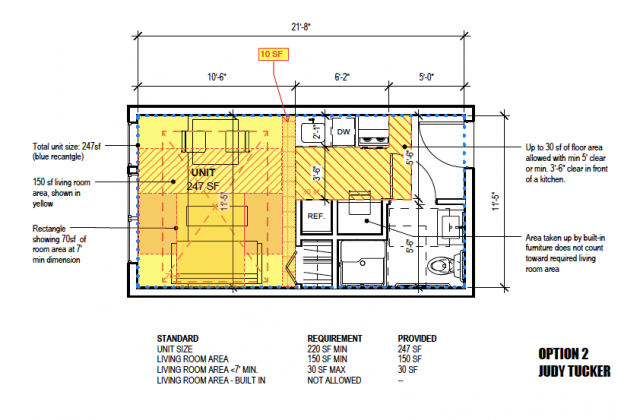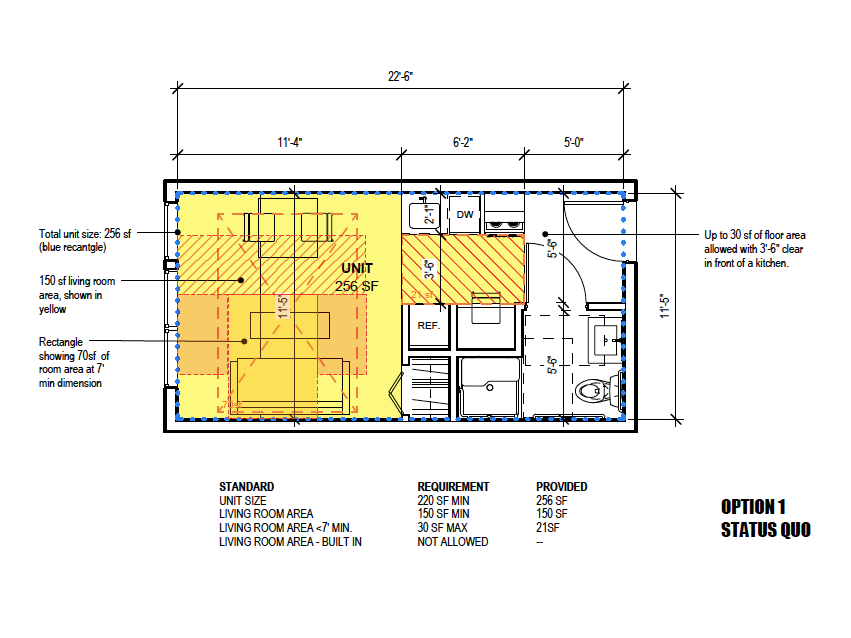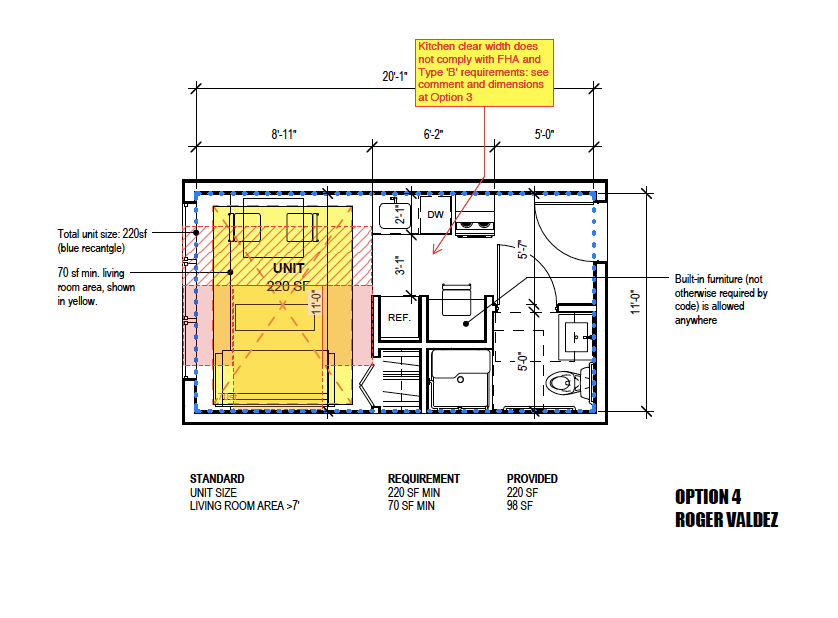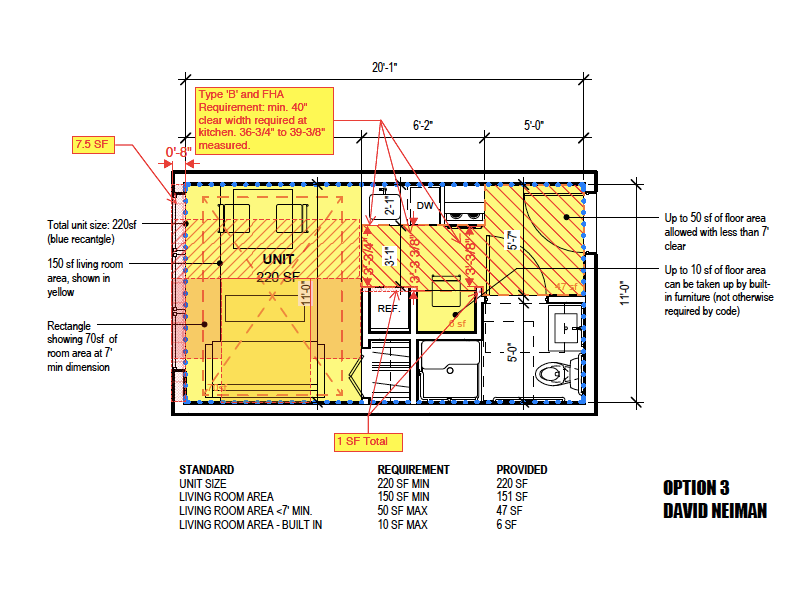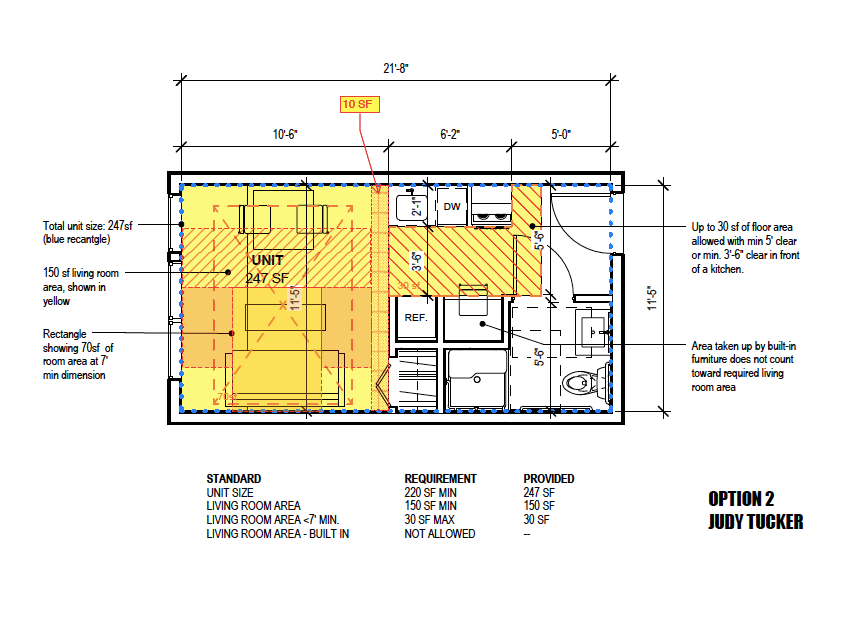CCAB Chooses Slightly More Flexibility for SEDUs
The months long progress over inches and feet at the Construction Code Advisory Board (CCAB) has come to a close and a recommendation has been made to modestly improve the friction between the land use code that allows a minimum sized unit for Small Efficiency Dwelling Units (SEDUs) of 220 square feet and the building code which has prescriptions that make achieving that size hard to do. When unit sizes get smaller it becomes more difficult to cram all the requirements mandated by the building code for minimum spaces for uses in the unit. Here is the status quo.
This option is forced actual unit sizes up into the 250 to 300 square foot range. Remember, the more units in a building the lower the rents. This fact was hotly disputed at CCAB and most members of the committee rejected the notion that when unit sizes are smaller and unit counts higher that rents are cheaper even though the price per square foot per unit is higher than bigger units. It’s just math. But this didn’t quite sink in. It was why I proposed the most flexible solution we could think of.
This option requires only 70 square feet of “living room” within the unit but keeps all the other basic requirements for other sizes. This option was rejected. In the parlance of Goldilocks, this option was too hot. Worries about bad design resulting or people eating on their beds ended up making most committee members uncomfortable. Then there is increases in density — simply more people being able to live in a building — that bothered neighborhood representatives.
David Neiman’s proposal was a little more nuanced keeping the 150 foot living room requirement but allowing more flexibility in its application in relation to other requirements and allowed for built in closets which wouldn’t be counted against the living room requirement.
We also considered a middle option of 100 square feet of living room as well. In the end, the recommendations spanned from mine, the most flexible and minimalist to the status quo. As the living room sizes got larger so did the possible exemptions to allow more flexibility in how the living room could be used (e.g. built ins or murphy beds).
In the end, the winner was what we called Option 2 by Judy Tucker, chair of the process.
This option is a modest increase in flexibility from the status quo, allowing 120 square feet of living room (min 7’ dimension) by allowing 30 square feet for built ins or other things.
If all of this seems confusing, it is, and I was there for all the meetings. Part of this is why this was a problem in the first place: developers, builders, and architects find it confusing too. The idea some of us had was just to make a change to make the building code and land use code line up in a way so very simple and very consistent that anyone could understand. While I don’t think we did that, my understanding is that Option 2 will end up allowing for smaller units, just not as small as the land use code allows, 220 square feet. There are just too many conflicts of things that need to be done in those 220 square feet to work. But adding up those 30 square feet means a few more units, and a few more people housed more affordably.
I suppose the ongoing disappointment is that the CCAB still seemed to believe in spite of the math, that the smallness of units has little to do with the price of rent but trying to cram more units to generate additional profits. The sense from the group, made up of professionals from the world of design and engineering, is that allowing too much flexibility would lead to bad design and people being forced to live in ways that are inhuman; this is a view shared with the neighborhood opponents. In the case of the neighborhoods it truly is a red herring; they really don’t care about the conditions, they mention them to create a state of affairs where those units won’t happen at all. The professionals, I think, really do believe they are looking out for future, suffering tenants.
In the end, Tucker ran a very fair and, I think, open process. She was very patient with people’s frustrations and did manage to keep steering us back from the big philosophical and economic questions to the Goldilocks question: which change to the rules would result in a mix of minimums and flexibility that is “just right.” For now, we have our answer.
